What is Cognitive Bias and How to Use it to Optimise Conversions
If you have viewed your potential clients and customers as completely rational so far you’ve definitely underestimated them. Rational choices are not always the case in website visitors. Irrational thinking is more often than not fueled by cognitive biases that have recurring patterns in most potential clients. And since people are often easily nudged by […]
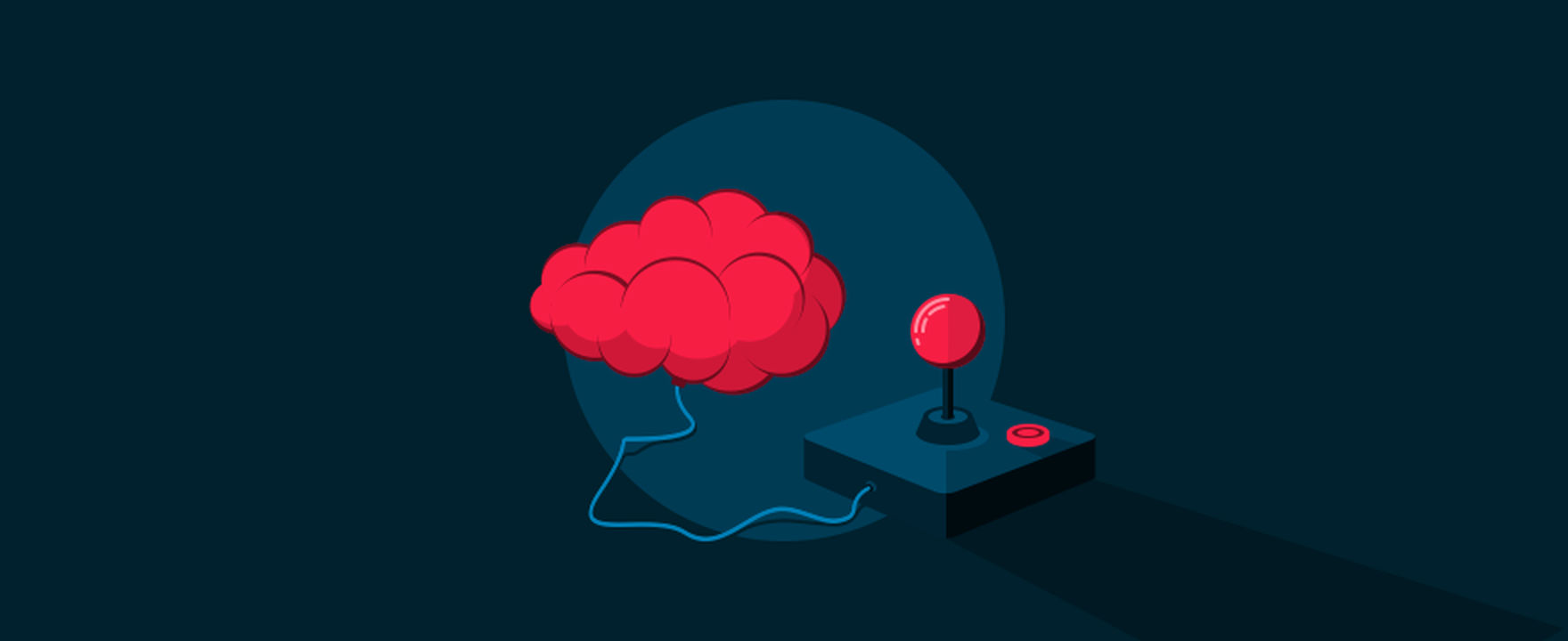
If you have viewed your potential clients and customers as completely rational so far you’ve definitely underestimated them. Rational choices are not always the case in website visitors. Irrational thinking is more often than not fueled by cognitive biases that have recurring patterns in most potential clients.
And since people are often easily nudged by contextual influences, many greatly successful companies dwell on that and turn it to their advantage. Can your business become one of them? The first step in this very rewarding process is to understand what a cognitive bias is.
What are cognitive biases?
Generally speaking, from a psychological point of view, a cognitive bias is a systematic error in the thinking of a certain individual, which greatly affects the judgements and decisions they make. The term is mostly studied in psychology and behavioural economics but it can be used to a greater extent in our everyday lives.
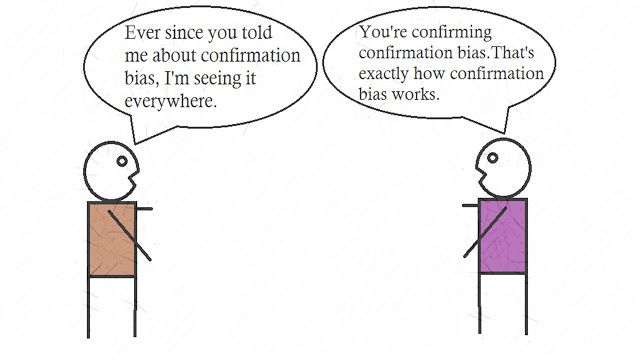
Confirmation bias, for example, is one of the most commonly found biases in gamblers or stock market enthusiasts. As soon as someone purchases a risky stock pick or a stock option, they most often than not start searching for their hypothesis to be confirmed by others.
Cognitive biases may impact each and every decision a certain individual makes ranging from what we buy to how we interact with strangers or our loved ones. There exist many cognitive biases in different areas that might influence the decisions of a certain visitor to your website. Financial biases, social biases, failures to estimate, impostor syndrome, and many others have been studied throughout the years. The full number of cognitive biases is close to a hundred and can be found on Wikipedia.
How to use cognitive biases to improve your marketing
For a website owner, most importantly, these cognitive biases influence your visitors. Simple webpage events like conversions, lead generation, or sharing your website with friends can greatly increase the likelihood of your website going viral or profitable. Let’s see which are the most common cognitive biases people fall victim to when browsing through our webpages and how to use them to your advantage.
1. The Bandwagon effect
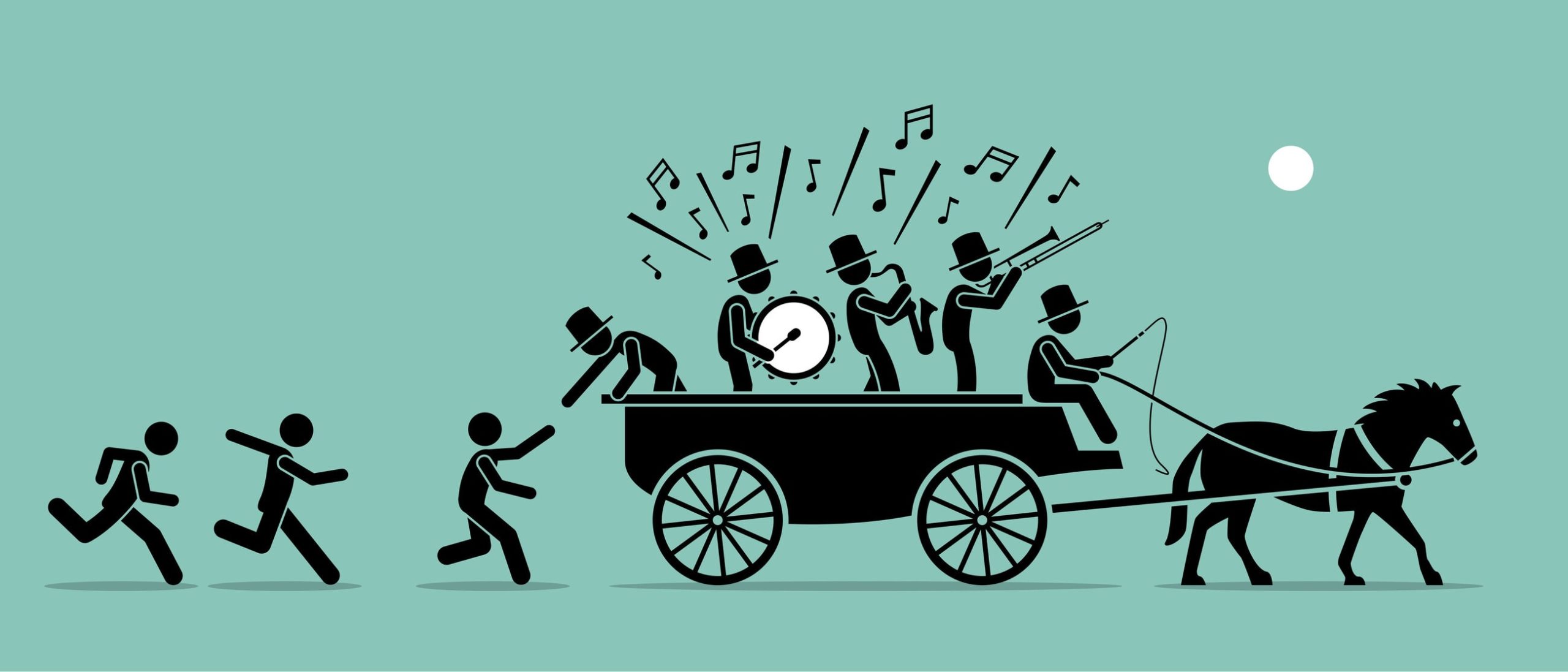
A lot of research on the so-called “Bandwagon effect” concludes that people in most cases act like herd animals by showing conformity, especially when in larger groups. A good example of the bandwagon effect is applauding. Sometimes someone does not quite start clapping at the right moment, but most of the times people follow anyway. Simply explained, the bandwagon effect consists of people doing or saying things, that they do not think or usually fancy, just because others are doing it.
So how does this affect your business?
- If you have focused on a niche community, and your product nicely fits it, find certain influencers that lead that community. People are very likely to follow them if they advertise your product naturally.
- If a visitor thinks everyone is buying your product, they might become more likely to purchase. Social proof plays a big role in fighting customer objections.
- You can add testimonials or social proof statements near the checkout to increase the conversions rate.
2. Anchoring
Anchoring is one of the easiest cognitive biases to abuse in terms of marketing. For example, some products advertise themselves as the best in [insert positive quality here]. What’s a Volvo? The world’s safest car brand. Well, they just anchored that into your mind by inventing seat belts and advertising as such.
Simply put, anchoring is the cognitive bias that places an initial piece of information in the mind of the individual and makes anything else pale in comparison and failing to dissuade them. A good example of getting an Anchor in someone’s mind is a certain customer seeing a product for $99 online, and now they’re browsing another website and see it for $149. The initial anchored information would be “I am searching for this product for less than $99” and they are less likely to purchase the expensive one.
This exact experience can be reversed on your website with sentences like “$149 value in the price of $99”, giving a very big competitive edge to your product, especially if you usually know where you rank. If people often visit another competitor website before yours, you would have a general idea of how to turn that around by using anchoring.
3. Availability cascade bias
Repeat a lie a hundred times and it might as well become the truth.
This is basically what the availability cascade is based on.
How can this affect your business?
- If you are operating in a certain niche, find influencers that can target your audience and let them help you extend your business. If they are busy, you can even hire someone to comprise a story visually for them to share.
- If many people talk about your business or website in a positive way, the word of mouth would work wonders for you and more people would convert more easily. If it does so in a negative way – vice versa.
- Refine your message, copy and design. Put inaccessible social media share buttons for you to start things rolling.
4. Context effect
Out of context memories are much more difficult for our minds to retrieve than in-context memories. For example, you are much more likely to get a clearer image of your summer memories while lying on the beach than say at home.
How can this be useful to your business?
Context is king in content-driven websites. If something special has occurred recently in the past or a trend is forming, you can capitalize on that. For example, in 2012 Gangnam style became a worldwide phenomenon that quickly took over the world for a few months. Businesses like Karaoke clubs advertised on it and cashed in big. What else could you do?
- You can craft your value proposition much more effectively if you vibe with your audience by providing them with the context to help your visitors retrieve memories. You may use certain images to manipulate the feelings of your customers. For example, everyone hates losing their keys, if you are selling an innovative key chain, hint at the reader how lost keys feel. Let them know that your product is out there to help.
- Context can be used in targeting too. If you are targeting B2B customers, target them during business hours (in the correct time zone). If you aren’t, research when is the most likely time for your audience to convert.
5. Confirmation bias
Let’s say you believe in a certain thesis, regardless of how unlikely it is. For example, many stock market traders often invest in stocks and later on fuel their enthusiasm and battle their anxiety by finding arguments that support their position. Confirmation bias is not easy to battle. The most effective way is to encourage an individual to aggressively seek information that counters our already accepted thesis.
If you are building a new website, and you strongly believe that the elimination of certain elements on your website would lead to more conversions you are more likely to disregard studies or tests that propose the opposing thought. This is one of the few biases that you should be trying to spot more of in yourself more than in your customers, as it plays a great role in the development of your products.
How can this be useful to your business?
- If a big portion of your clients already have an idea in their heads of what your product or service might entail, then they are already biased in a way. Instead of trying to alter the already established biases in your customers, you should focus on consistency in contents and familiarity.
- When you develop tests, keep an open mind when reviewing the results. If you find yourself inclining toward something, consider asking other people for their opinions as well.
6. Contrast Effect
This is an unconscious bias that occurs when a certain individual judges two things and compares them to one another, instead of doing so individually. There exist two types of contrast effect – positive and negative. The positive contrast effect means that the examined subject is viewed better than it would be viewed if it weren’t compared to something else. The negative means it is being viewed as worse.

If you observe the image above you would see that the grey square in the middle of the circle appears to be two different colours when compared with the circle’s colour. Well, it isn’t. It’s the same grey square, which only appears to be lighter because it is compared to a darker background. The way our minds percept things is via comparison. If you’ve eaten raw sugar, you are less likely to perceive a fruit as sweet. This works for products and services as well.
How can this affect your business in a positive way?
- Creating contrasts between your amazing product and less amazing ones in the same category might give you an edge. Don’t mention any names though.
- If you know where the majority of your website visitors come from, you are more likely to know what information have they been recently exposed to. Contrast your product or website in a good way compared to that and capitalize.
- Elements of surprise work wonders. All clients expect certain things to happen after they’ve performed a certain action. Do the extra step and let their minds create a special place for the memory of your product. Yes, all clients expect a handbag to be given out with a larger product in a retailer, but not all of them expect it to be free and made out of high quality branded papery. Most likely, you’ve been to one of these stores and you’ve created a small memory of it in your mind unconsciously, mostly due to the contrast effect.
7. Backfire effect
The backfire effect is described as the process of people searching for contrary information to their thesis and rejecting it to further believe even more strongly in their opinion. Simply put, it’s the strengthening of one’s opinion defensively when contrary evidence is presented to them.
If a certain individual believes fanatically in some fact, nothing can change their minds. This is where emotional persuasion comes in handy. A good example of that is Apple fans stating the Apple devices are much better than PC in all they do. Yes, both types of operating systems have their advantages but strictly relying on one is absurd.
How to combat the backfire effect?
- If you have reason to believe that your customers have fallen victim to a fanatical comparison between products, you can run a double-blind test to show them the differences of your product without stating which is your product and which is a randomly generated competitor product. This can be hosted on most websites regarding most services as a demo. If you find yourself a victim to the backfire effect you can perform the same blind test on yourself and make a correct unbiased decision.
- Qualitative research is often the right way to reach the hearts of your visitors. Pull some surveys and study your visitors, offer coupons or another incentive for them to share some information about themselves that might give you an edge and later on capitalize by working within your visitors’ core beliefs.
8. Belief bias
Belief bias is the tendency for an individual to hold onto a set of beliefs despite being presented with factual evidence that proves counter argumentative. The simplest example of that is people who view themselves as obese when they aren’t.

Many websites of products and services, as well as reviewers who try to sell them often exaggerate the viability of these products or services. If you oversell your product, you are less likely to gain the trust of your visitors and convert them to loyal customers. Be honest.
How can you use this to your advantage?
- Avoid all sentences that sound too good to be true for your product. If you are offering the best quality product in the sector and the lowest price, that may also sound fishy to your potential customers. Many people often choose not to purchase a product only because the price was suspiciously low it was too good to be true.
- Show examples or add a storyteller that explains how your product or service would directly improve the life of your customers if bought. Avoid showing only your product, and not the result of it. (A great example can be Old Spice, which turns any boy into a man right away. It’s not your ordinary deodorant.)
9. Clustering illusion
Or also known as the “Seeing phantom patterns” syndrome. Clustering illusion is most often observed in behavioural finance where an investor observes certain patterns and gives them more meaning and weight than they would usually have. Not only is it a recurring theme in finance but also can be found in gamblers. Let’s say you flip an even coin 100 times and you see 12 consecutive flips that land on tales. Most people would argue that it is more likely the coin lands on heads next time. Well, it’s still a 50-50 chance, even if there are 10+ consecutive landing on one side, which is highly unlikely.
How can this affect you?
- If you are spotting patterns where there aren’t any, that might influence your decision making in investing. You can combat and prevent this by calculating correct sample sizes each time you do a test. Avoid stopping tests preemptively and running to conclusions that aren’t there only because you’ve spotted a phantom pattern.
- Most people, after spotting a certain trend, start looking for the same one subconsciously and tend to ignore different valuable insights.
10. Framing effect
The framing effect can simply be explained by one sentence: “Drawing conclusions differently from the same evidence presented to you multiple times in different forms.”
Marketers have gathered many strategies over the years thanks to the research done by Amos Tversky & Daniel Kahneman. Some of the most commonly used tactics by marketers revolving around the framing effect are:
- In the mind of a consumer small discounts or savings on small investments are more gratifying than large ones on larger scales. For example, most people would prefer saving 5$ on a $25 purchase than saving $500 on a $2500 purchase.
- Positive associations and wording carry positive messaging and negative associations carry negative messaging. You want to associate your product with positive thoughts.
- When speaking of gain, certainty is preferred over possibility. If your product offers 100% certain benefits list them as such.
- When speaking of loss, the possible loss is always preferred to a definite loss in the mind of the consumer.
How can you use this information to the advantage of your business?
- When thinking about the copy and design of your value proposition try to guide every visitor to the conclusion you want to portray. Whether you would use storytelling, calls to action, persuasive data or deep inspiring questions is up to you and to your research’s conclusions.
- It is very important in what form you present the data supporting your product. It is better to show than tell when talking about marketing. For example, if your product is a revolutionary weight loss supplement, you can state your customers as 1,5M lives changed for the better, instead of 1,5M clients.
- The different ways you might ask a question might give you different results, even if it’s the same question. (Speaking of qualitative research.) Ensure your wording is always clear and understandable.
11. Illusory correlation
The cognitive bias of illusory correlation is the inaccurate perception of a relation between unrelated events. Yes, it might be a full moon today, but you have no evidence that this is strictly influencing your headache without conducting research.
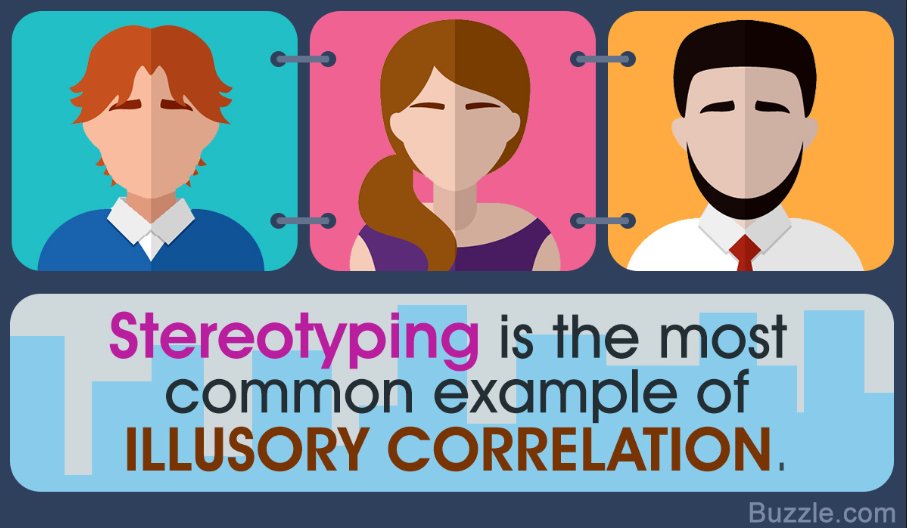
Stereotyping is one of the most commonly met examples of illusory correlation. The fact that someone comes from a certain race or part of the world does not mean that they are less or more inclined to do something or to have a certain quality. There are many cultural, political, and other factors that play a role in the development of character. Well, of course, if a person is against the possession of firearms, you would be less likely to be able to sell them one, regardless of the value proposition of your business.
How to use illusory correlation to our advantage?
- Separate events if they have no correlation. If you’ve started a new marketing campaign and you are doing a test on changing certain CTA buttons on your website, for example, the increase in conversions can be in a combination of both, or just one of the two factors. Avoid changing multiple things at once when testing elements.
- Our brains look for trends and patterns even if they aren’t there. This can impact the results of your tests and reports. Have that in mind when doing analysis and making decisions.
- Consider external factors when checking the results of tests. Holidays, days of the week, business hours, certain events, and many other things can influence the outcome.
- Use large enough samples. Making unrelated connections between subjects is often most commonly experienced when there is a lack of statistically significant data points.
12. Curse of Knowledge bias
If you are an expert in a certain field you find it much more difficult to put yourself in the eyes of a person who has no idea of what’s going on in the same field. People who are experts on code, for example, would find it hard to explain to their grandmothers what they work and how they achieve what they do.
How to protect yourself from the curse of knowledge?
- You are likely to know everything about your product like the back of your hand. Your customers aren’t expected to do so. So don’t talk to them as if they’ve developed the product alongside you. Something that might seem obvious to you might be very distant to your visitors.
- Use focus groups and let them ask you questions about how your product works. Write notes. This is what needs to go as a description on your website about your product.
- It is more likely that you use advanced language about your product and terminologies that your targetted audience might not understand completely.
13. Unit bias
Have you started a book and known right away that it’s bad or it isn’t for you, but you’ve finished it anyway? Well, that’s the unit bias. Finishing actions regardless of them being unproductive or unpleasant just for the sake of it.
- If you know that your website has a high bounce rate, it might lack storytelling. We, as human beings, are programmed to look for an ending. If you create a visual story on your website, people might stick just for the sake of it and might have a much bigger chance of converting afterwards.
- Check your conversions funnel. Eliminate anything that might be a distraction or that might be unnecessary. Make everything as intuitive as possible and prompt people to finish what they started.
14. Empathy gap
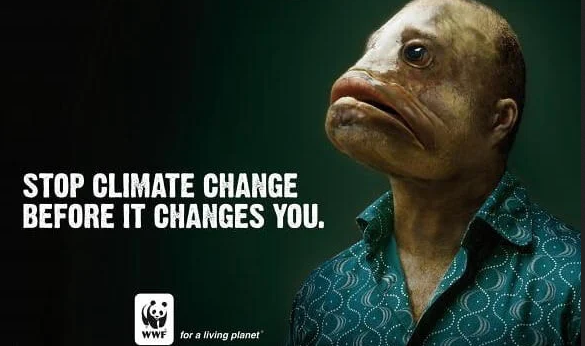
In their advertisement, WWF focus on spiking Fear for others and yourself. We often underestimate how much emotion is used in advertising and most people think you need to convince someone rationally in order for them to make a decision. A large portion of our decisions are not rational, and an even larger so is partially reliant on emotions, as well.
How to use the Empathy gap to your advantage?
- Don’t underestimate the role of emotions in advertising. We might be rational people but our decisions aren’t always.
- Have better control over your own emotions as they might impact conversions in a negative way. The emotions of your visitors are not always the same as your own.
- Craft a more emotional copy and UX or design for your website. Use a combination of rationality and emotion in order to convert as many visitors as possible.
- Conduct research in order to get a better understanding of which elements influence the emotions of your audience better. Then craft a better copy based on these.
15. False consensus effect
The false consensus effect consists of people thinking others agree with them more than they actually do in reality. If you’ve had a marketing consultant state to you undoubtedly that “Everyone hates pop-ups on websites!”, or that “Nobody fills in forms!” you’ve witnessed the false consensus effect in action.
How can this affect your business?
- Don’t let others persuade you with absolutes. Testing, research and analysis can give you good first-hand data to later build your decision on. All false consensus effects can have a negative impact on the way you write your copy or design your website, ultimately leading to fewer conversions.
- Don’t overvalue individual opinions. Your entire audience might be different and one opinion shouldn’t be weighed in more than others. Every person is biased in a different way and has their own feelings and assumptions.
- Use only data to optimise your conversions funnel. Personal opinions are personal opinions and that’s that. Even your own. Don’t overestimate them.
16. The bias of Post-purchase rationalization
Have you ever purchased something and later you try to persuade yourself that it was a good decision and worth it? Post-purchase rationalization is a cognitive bias where one tries to convince themselves that they’ve made the right choice.
How can you abuse that to the advantage of your business?
- More often than not, people are social beings. They not only want to find affirmation within themselves but in others as well. Congratulate your visitors on their online purchase and even more so, encourage them to share with friends on social media what they’ve acquired. That will not only more likely make them purchase again, but would also spread the rumour of your products.
- Use positive words in post-purchase emails or on page-messaging. Encourage returning customers and offer discounts for later use.
- People that shop on emotions will rationalize their purchases afterwards.
17. Humour effect

Studies show that humourous presentations are much more likely to be remembered than ordinary ones. Using humour might not suit every product, as B2B focused services or healthcare have no place for humour. Although there are more important things than humour like design and an understandable flow, humour might play a vital role in keeping your visitors engaged, if the product allows it.
How to use humour to spread your business?
- Humourous ads, conversations or presentations are much more likely to be remembered. And more importantly, to be shared with friends, acquaintances, colleagues and family members.
- Always be careful not to completely blast your product out of the way and people to remember only the funny advertisement but always be like “What was that product with the funny bear in the ad?”
- One-liners are great, catchy songs also tend to be remembered easily.
18. Attentional Bias
Attentional bias is the tendency of us perceiving differently, being influenced by recurring thoughts. If something touches us while we reflect on a fact we will be distracted.
How to eliminate attentional bias on your website?
- In your sales funnel, try to eliminate any distractions like ads from different sites or external links that are unnecessary.
- The more often someone sees your logo or brand name, the more likely they are to have you at the tip of their tongue and spread information for you or even purchase.
- Retarget your visitors with ads. Second-time visitors are very likely to convert.
19. Status Quo
Studies show that people are more likely to change their partner in life and divorce than to change their bank account. We are creatures of habit and many companies that profit out of subscription fees would do everything to keep their clients tangled in never changing to a competitor service.
Insurance companies are another good example of proper Status Quo use. It is very tedious to change from one broker to another. Moreover, such businesses like insurance often rely on you being lazy and offer to take you through the process, all you need to do is pay.
How to use the Status Quo cognitive bias to your advantage?
- Minimise the friction to re-purchase for your customers.
- Show your clients what they’re missing if they don’t make a second purchase. Offer discounts, or more value, hook them in. Loyalty schemes exist for a reason.
- If you run a subscription-based business, establishing it as a Status Quo for your clients should be your number one priority.
20. The Mere exposure effect
This one is self-explanatory. The more your clients are exposed to your product, the more likely they are to think of it. If they believe a certain product is popular in the niche, they will often think of it first rather than of its competitors. Moreover, famous products are more easily trusted by consumers.
Conclusion
With more than a hundred cognitive biases out there, and many yet unstudied, you have a wide variety of tools to work with in order to make your website convert more. Make sure to use focus groups when implementing new decisions, and try to stay away from your own biases when making important decisions.
Everyone is affected by cognitive biases and being aware of it gives you an edge over your competitors that aren’t. Understand your visitors better and capitalize.

